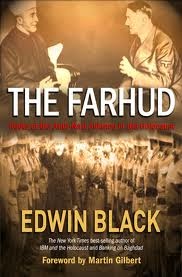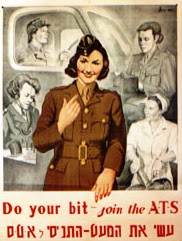LYN JULIUS:THE POGROM IN IRAQ ON JUNE 1941….SEE NOTE PLEASE
The Farhud against Iraq’s Jewry and Nazi Influences in the Middle East
It’s the 70th anniversary of the Farhud (Arabic for “violent dispossession” or “pogrom”), which occurred in Baghdad on the afternoon of Sunday, 1 June 1941 (the Jewish festival of Shavuot) and continued until noon the following day when troops brought it under control.
There’s a good online account of the Farhud and what led to it and transpired from it here: http://www.ushmm.org/wlc/en/article.php?ModuleId=10007277
As that account points out:
“In the 1940s about 135,000 Jews lived in Iraq (nearly 3 percent of the total population), with about 90,000 in Baghdad, 10,000 in Basra, and the remainder scattered throughout many small towns and villages. Jewish communities had existed in this region since the 6th century BCE, hundreds of years before Muslim communities established a presence in Iraq during the 7th century. The Jews shared the Arab culture with their Muslim and Christian neighbors, but they lived in separate communities. Jewish assimilation into Muslim society was rare.
With the establishment of the Iraqi state under the British Mandate in 1921, Jews became full-fledged citizens and enjoyed the right to vote and hold elected office. The Jewish community had between four and six representatives in the Parliament and one member in the Senate…. Its elite included also high-ranking officials, prominent attorneys and dignitaries, and wealthy merchants. This status of the Jews did not change in 1932, when Iraq gained independence under The British informal rule.”
However, during 1933-34 Hitler’s Mein Kampf (translated into Arabic) appeared in instalments in a Baghdad newspaper, Al Alam al Arabi. The translator, Yunis al-Sabawi, headed the Futtuwa, a para-military youth organisation modelled on the Hitlerjugend. In October 1939, following the failure of the Arab revolt in Mandate Palestine that had broken out in 1936, the notorious Hajj Amin al-Husayni, Grand Mufti of Jerusalem, arrived in Baghdad, where he indulged in pro-Nazi, anti-British activity. On 2 April 1939 an anti-British nationalist politician, Rashid Ali al-Kailani, supported by al-Husayni, overthrew the pro-British authorities in a coup, and al-Sabawi became a member of his pro-German government, which, was destined to be shortlived, collapsing in May.
When, on 1 June 1941, Baghdad’s Jews turned out onto the streets to celebrate Shavuot, they were set upon by nationalist elements who believed that they were celebrating the restoration of pro-British rule:
“Iraqi soldiers and policemen who had supported Rashid Ali al-Gailani’s coup d’etat in April and Futtuwa youths who were sympathetic to the Axis incited and led the riots. Unlike in previous incidents, rioters focused on killing. Many civilians in Baghdad and Bedouins from the city’s outskirts joined the rioters, taking part in the violence and helping themselves to a share in the booty. During the two days of violence, rioters murdered between 150 and 180 Jews, injured 600 others, and raped an undetermined number of women. They also looted some 1,500 stores and homes. The community leaders estimated that about 2,500 families – 15 percent of the Jewish community in Baghdad – suffered directly from the pogrom. According to the official report of the commission investigating the incident, 128 Jews were killed, 210 were injured, and over 1,500 businesses and homes were damaged. Rioting ended at midday on Monday, June 2, 1941, when Iraqi troops entered Baghdad, killed some hundreds of the mob in the streets and reestablished order in Baghdad.”
By 1951, 124,000 Iraqi Jews, no longer comfortable in the land where countless generations of their ancestors had dwelt, had fled to Israel.
Owing to strict wartime censorship, the Jewish Chronicle did not learn of the Farhud until weeks later. Its issue of 15 August 1941 revealed:
‘Little more than two months ago there took place a horrible pogrom in the Middle East. It occurred in Baghdad on the two days before the entry of the British troops, and some details of it are furnished by Mr Edward Kennedy in an Associated Press dispatch from that city. According to him, some of the local policemen joined in the looting of the Jewish quarters which was started by deserters from the retreating Iraqi relief army.
“Shooting locks off or battering doors, pillagers rushed in shooting or knifing anyone in their way. Mutilated bodies were flung out of windows…. Furniture was pulled apart and tiles torn up from the floors in the quest for gold pieces. Some Moslem homes were sacked, and in many cases Moslem looters killed one another. Almost all the British homes also were plundered.”
In all the loot is valued at £500,000 [about £25million in today’s money – D. A.].
Two particular points about this ghastly incident are to be noted. The first is that just as the Serbs in Croatia are today compelled, like the Jews, by local quislings to wear a distinctive armlet, so the Jews had non-Jews as fellow-sufferers in Baghdad. Hatred and trouble begin with Jews but do not stop there.
The second point is that the subversive and lawless class in Iraq is sufficiently large for the dispassionate observer to discount some of the effusive flattery lavished on Arab civilisation but so mysteriously withheld from Middle East Jews. And the best way to promote, even unintentionally, ill-will and outbreaks of violence against Jews of that area is for the government publicly and almost ostentatiously to discriminate against them. [My emphasis]’
A week later the Jewish Chronicle carried an extract from an editorial in the Manchester Guardian, one of the most pro-Zionist – if not the most pro-Zionist – of all the newspapers in Britain:
“After the last war we gave the Arabs freedom and great possessions, keeping only a corner for the Jewish National Home. But when that great constructive idea justified itself, we allowed the small and timid minds of our own rulers to go back on it in the White Paper policy. Now that the forge of war is again open, we ought to have it clear in our minds that any scheme which gives still further satisfaction to the Arabs must include justice to Palestine, the abandonment of the White Paper (which has neither legal nor moral validity) and the establishment of a well-based independent Jewish State.
The British policy of the National Home would stand even if there were no persecutions or pogroms of the Jews. But of them, in the East as in the West, there is no end. Events recently took place in Iraq which passed almost unmentioned in this country: we maintain a drastic censorship in the Middle East, but news eventually comes from Cairo, Jerusalem, and the United States … there was a pogrom against the Jews ….
Well might the daughter of Zion bewail herself, saying ‘Woe is me now! For my soul is wearied because of murderers.’ The Baghdad Arabs were ‘taking it out of’ the Jews because we in Britain had carried out our promise to create a Jewish National Home in Palestine. But we for our part ought to let the Jews fight for our cause as Jews (as the Poles do and the Czechs) to organise them more thorughly for the defence of their own country – a little more of this is now being done – and to establish a Jewish Palestine that can live, defend itself, and bring home its people, free or persecuted, from any part of te world. Without such a State, which it is our duty to assure, there can be no lasting settlement.”
And what of the Mufti, Hajj Amin al-Husayni, who had been one of the fomenters of the Baghdad pogrom?
That dyed-in-the-wool Nazi sympathiser and blue-eyed “honorary Aryan” fled to Berlin, where he was cordially received by Ribbentrop and Hitler. He requested a declaration of support for the right of the Arabs “to solve the question of the Jewish elements in Palestine and other Arab countries … as the Jewish question was solved in Germany.”
After the Fuehrer promised him that Germany would bring about “the destruction of the Jewish element” in Arab lands presently under British control the old demon went to the Balkans, and in Bosnia recruited Muslims into units of the Waffen SS that slaughtered Serbs and gypsies as well as Jews in Croatia and Hungary.
In 1942, following the fall of Singapore, a broadcast in Arabic from Rome reported that he and Rashid Ali al-Gailani had sent a message to the Japanese Emperor congratulating him on that event, declaring that it “greatly encouraged” the Arab world, and that the Arabs hoped that the Axis Powers would soon liberate them from “the British-Jewish yoke”.
He died in 1974, having evaded prosecution by finding asylum in Egypt and Lebanon.
Of course, his poisonous legacy, and that of other Arab pro-Nazi sympathisers like al-Gailani and al-Sabawi, lives on, as seen in the Der Stuermer-style antisemitism that still circulates in the Middle East.
Comments are closed.




